Arsenal youth academy product Folarin Balogun (179cm/5’10”, 66kg/145lbs) has joined Ligue 1 side Reims on loan for the 2022/23 campaign. The England U21 international has already opened his goalscoring account in France, bagging his side’s only goal in their 4-1 defeat at Marseille in game week one.
Balogun spent the second half of last season on loan at EFL Championship promotion contenders Middlesbrough, scoring three and making three assists, while he enjoyed a positive two and a half campaigns of Premier League 2 football before that.
The New York City-born forward has plenty of exciting qualities in his game that have made him an important part of Lee Carsley’s England U21 side of late. Two major strengths in the attacker’s game are 1. His intelligent off-the-ball movement in attack to set him up in great goalscoring positions and 2. His excellent shot accuracy — he’s brilliant at hitting the target while striking the ball low and hard.
However, major question marks remain over whether or not Balogun will ever become a regular member of Mikel Arteta‘s first team squad. Why? Because the 21-year-old is still very raw in plenty of areas and perhaps needs to hone his game in several ways in order to be ready for first-team football at a club like Arsenal.
This season at Reims will be a great opportunity for Balogun to spend a campaign as part of a team in one of Europe’s strongest leagues, working with top-class players and coaches at a high level, perhaps giving him a chance to grow and develop in the necessary areas more than ever before. Of course, the possibility of not cutting it at the level is also there, we can’t ignore that. So, this season will tell us a lot about Folarin Balogun and will likely be a crucial one for him.
This tactical analysis aims to provide analysis of where Balogun must develop, or in some cases alter his game during his loan spell with Reims if he is to make progress in reaching his potential. We will analyse what his role has typically been within his team’s tactics as well as what jobs and responsibilities within his team’s setup might suit him best.
We hope that this scout report shines a light on Balogun’s key areas of improvement, which will be interesting to observe over the course of the 2022/23 campaign.
Balogun’s playing style
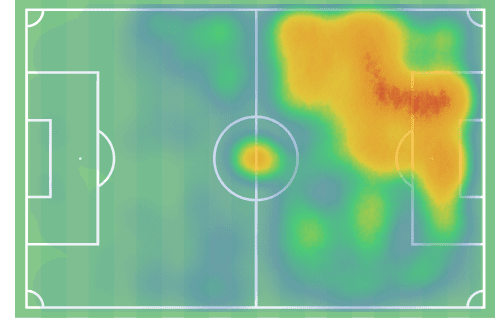
Firstly, Figure 1 shows us Balogun’s heatmap from all competitions last season. This heatmap shows us that the 21-year-old Arsenal man loves to occupy the left side of attack, mostly playing towards the left of centre-forward but also commonly drifting out onto the wings.
It’s common to see Balogun receiving the ball with his back to goal centrally, often doing so while dropping out slightly towards the left wing. Thanks to his intelligent movement, he’s good at creating positive angles for teammates to play off of him, though he can improve his first touch and one-touch passing ability, as he can be a bit heavy-footed with the ball at times in such situations.
Balogun is lethal when played in behind the opposition’s backline with space to run into. He has good pace but doesn’t use it as often as would perhaps be optimal. Balogun has the qualities of a striker who could pose a real problem for the opposition as a runner in behind but he could make the runs to exploit this strength in his game more frequently. These kinds of movements are often where his goals come from.
However, Balogun likes to drop off and link up, while he likes to receive the ball to his feet a lot too. At present, he may be best suited to playing as a left-sided attacker in a 4-3-3 or a left-forward in a two-man strike partnership alongside a major focal point.
Additionally, Balogun has great qualities to function best in a counter-attacking setup, as he typically excels in quick attacks both in terms of his ability to link up play with teammates and his ability to exploit space behind the opposition’s backline, provided he makes the runs for that, which are sometimes absent in his game.
Runs in behind
Figures 2-4 show a great example of Balogun operating as a forward on the left side of attack, dropping off to link up with teammates, engaging in some one-touch football and turning after his pass to provide the team with an option in behind, as well as progress into a high-value shooting position as his side enters the final third.
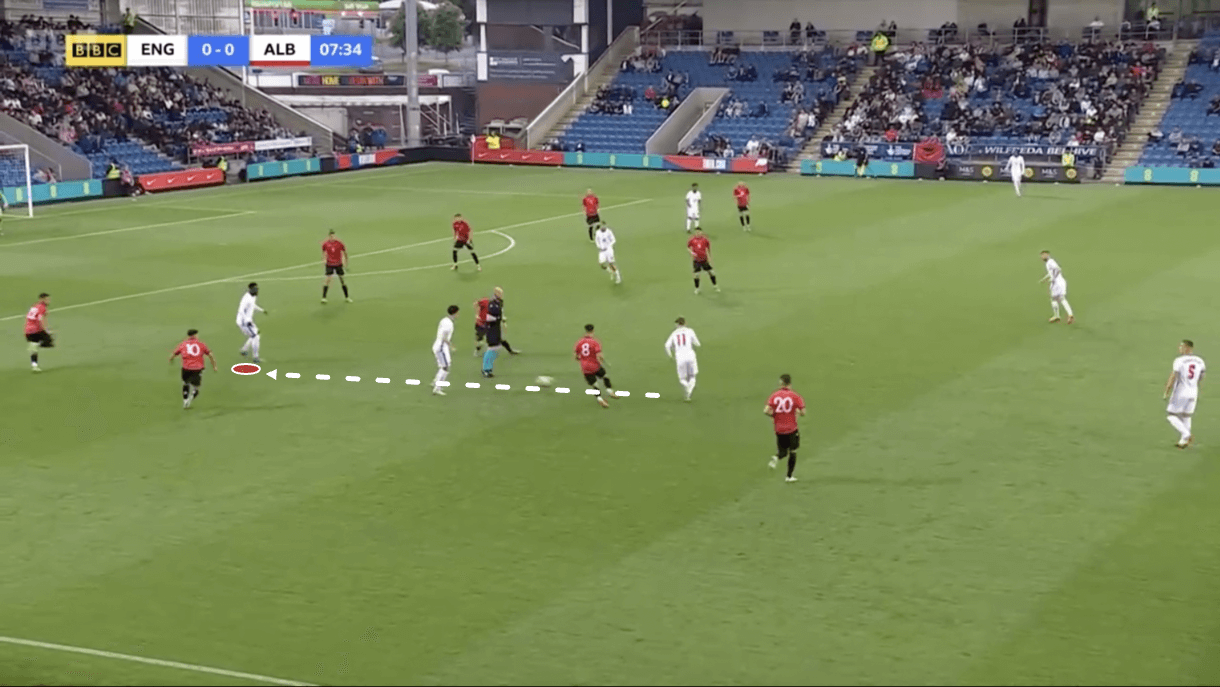
Firstly, in figure 2, we see Balogun receiving the ball in the type of position we talked about in the previous section with his back to goal and space between him and the nearest opposition defender. Just before this image, he dropped off slightly from the opposition backline to make himself available for his teammate on the ball to find.
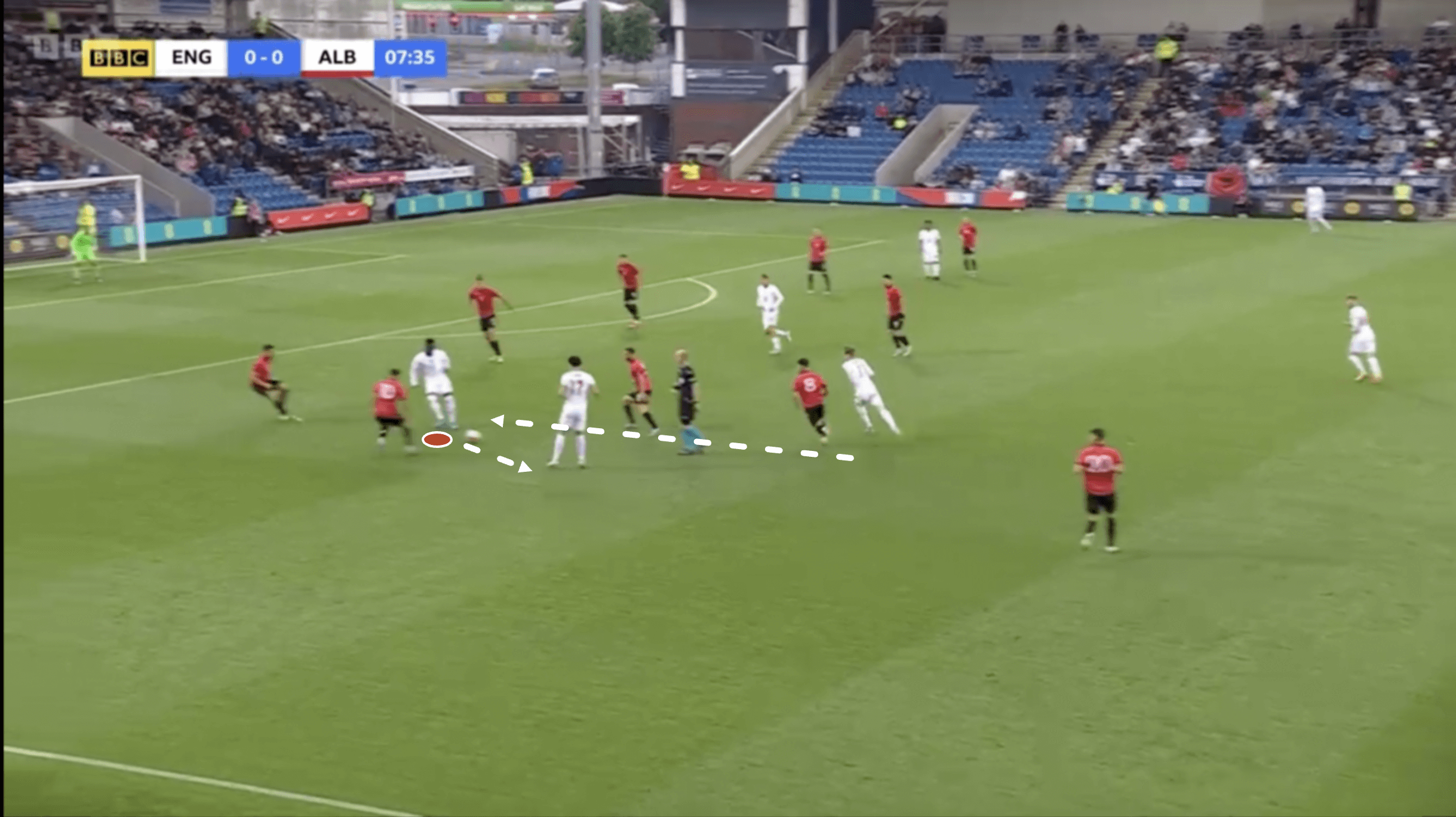
As is evident from figure 3 as the play moves on, Balogun made this move to facilitate progress to the left central midfielder who was blocked from the passer to Balogun by an opposition defender in figure 2.
However, the route to Balogun was open. As a result, the Arsenal man took it upon himself to drop, and make himself available for that teammate to link up with and receive before quickly bouncing the ball back off his stronger right foot to the advanced midfielder next to him, who can now receive very easily while facing forward thanks to the link-up play between Balogun and the deeper midfielder.
This is an example of the third man principle in action and Balogun’s intelligent tactical understanding to pull the move off seamlessly. Thanks to his movement and disciplined play on the ball, he facilitate progress from player A to player B, by acting as player C (the third man).
It’s common to see the attacker look to link up with teammates like this and facilitate such progression. It’s an important part of his game but one that he’s far from perfect in executing, even if he’s good at spotting the opportunities to do this. The consistency of his first touch and one-touch passing accuracy is cause for some concern about his suitability for this role at the highest level.
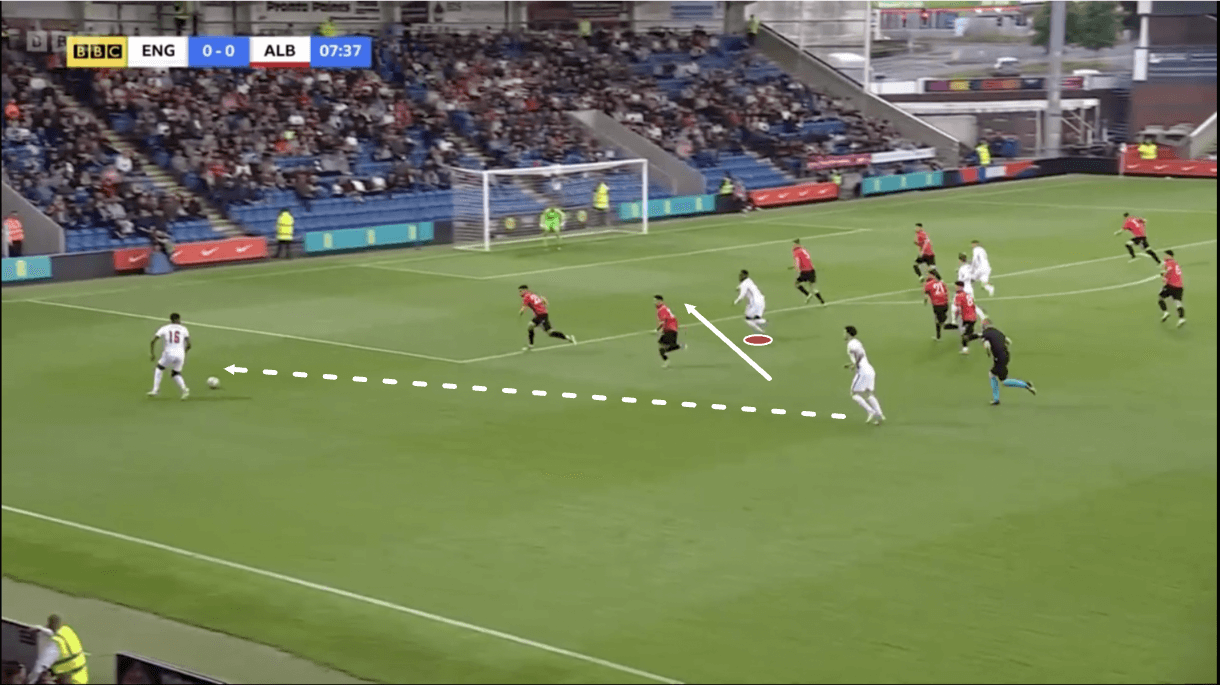
After laying the ball off and seeing the receiver spread the play out to the overlapping left-winger, Balogun turns and drives into the box off the ball, making himself a problem for the opposition backline to worry about and an option for his creative teammate on the wing.
As play moves on, we see that the cross goes beyond Balogun and deeper into the box but the 21-year-old performed some very intelligent movement here in quickly turning and driving into the danger zone to either find space himself or attract a defender towards him, thus creating extra space for someone else.
In this regard, Balogun’s movement is good. He is good at providing options in the box during the chance creation phase. Where his movement can improve is the ability to spot opportunities to spring a run in behind the opposition’s backline and either create a passing opportunity for a teammate or force the opposition defenders to react, perhaps then creating more space in front of the backline.
Balogun doesn’t dictate the opposition’s defence as much as you might want from the centre-forward in the team, sometimes making life too easy for the settled defence to cope with him. This is an area he can improve.
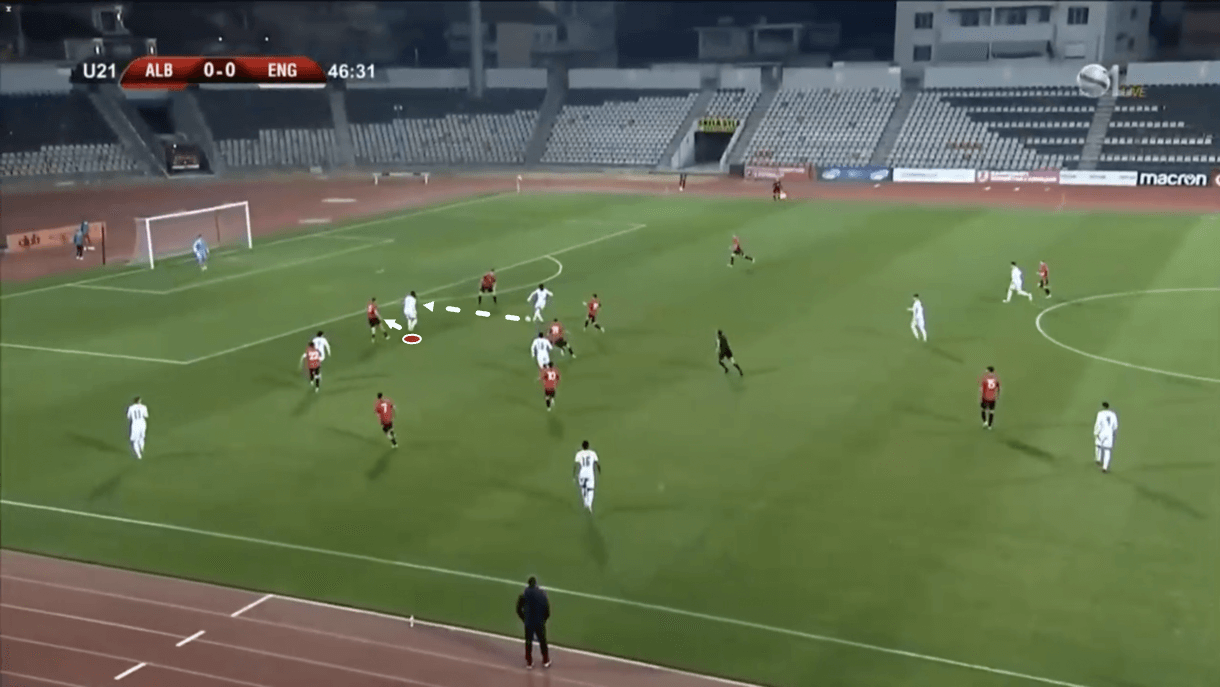
Balogun can be very dangerous when played in behind the opposition’s backline, with figure 5 above providing one such example. Here, he quickly turns and darts in behind as the ball carrier receives and moves into a good position to create a chance for the 21-year-old forward.
Balogun’s pace and shot accuracy make him a threat in such situations, though he could probably do a better job of hitting the corners of the net rather than just the target, as his shots sometimes make life too easy for the goalkeeper as well. While it’s good to hit the target, hitting the ‘keeper is no good and the forward could, perhaps, develop his finishing quality in this way, sacrificing some accuracy for higher value areas of the net.
First and foremost, though, Balogun needs to work on recognising the skill he possesses in threatening the space behind the opposition’s backline and do a better job of recognising opportunities to spring a run in behind to exploit this strength in his game. At present, he doesn’t offer these runs enough, nullifying this strength in his game.
He perhaps focuses too much on receiving to feet and not enough on driving in behind even though this is something he could be very useful at for his side.
Receiving under pressure
As a forward (typically a centre-forward) who likes to drop off and make himself available for teammates to play off of and link up with, Balogun often finds himself on the ball with his back to goal under pressure. However, this is a scenario that he doesn’t perform particularly well. Under pressure like this, the centre-forward’s decision-making often appears rushed and it’s common to see him opt for a worse option than the best one available at that moment.
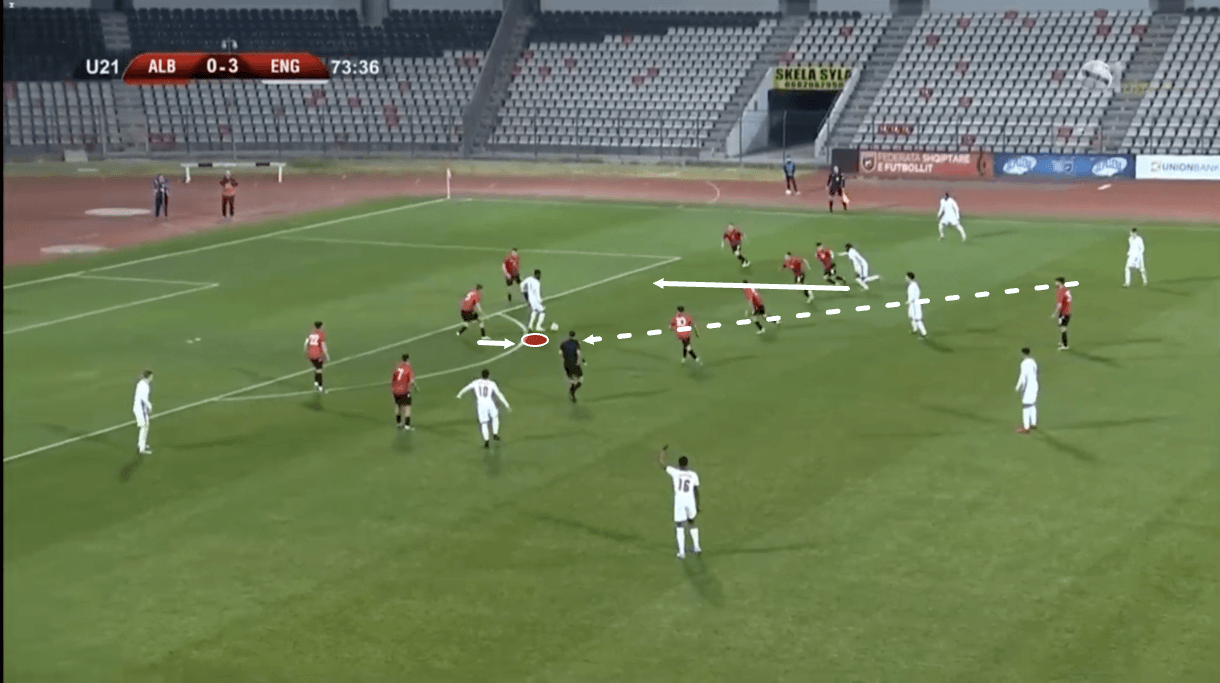
Figures 6-7 provide an example of this. In figure 6, we see Balogun on the ball with his back to goal having just received it from a deeper teammate. At this moment the forward receives, we notice that an attacker to his left (in his team’s inside right channel) sees the opportunity to burst away in behind the opposition’s backline, providing Balogun with a through passing option, provided that the forward gets his head up and takes his time on the ball to pick out that run.
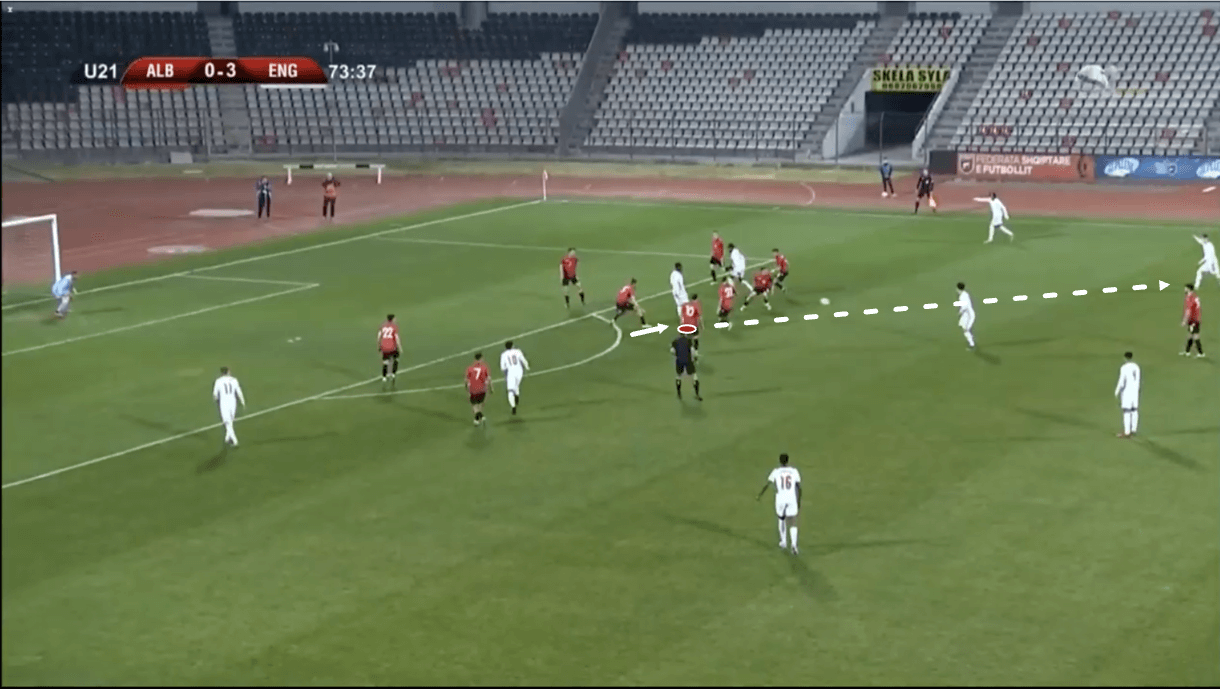
However, as play moves on and the opposition closes in around Balogun, the pressure proves too much for the young attacker to pull off the creative pass to get in behind the opposition’s backline, and he ends up sending the ball back to the player that initially found him instead.
There are a couple of things to note here, the first being that Balogun could’ve done a better job of scanning on receiving the ball, which would’ve provided him with a better visual understanding of how the pitch was laid out around him and what runs were being made. The attacker failed to do this, and this will have undoubtedly hurt his decision-making process.
In addition, as the opposition closed in around him, the forward failed to remain calm and composed, instead panicking and immediately taking the safer option as he got his head up — sending it back to the initial passer.
This isn’t necessarily a bad move, the opposition were now disturbed and some players dispositioned as a result of Balogun’s movement and reception of the ball, while the player he passed to had a good view of everything in the final third and a lot of space to operate in. However, it did still leave his team in a less threatening position than they could’ve been and Balogun ideally would’ve split the defence with a through pass and found the runner moving in behind the backline to create a goalscoring opportunity.
His failure to do this allowed the opposition some time to regroup and frustrated the teammate who made this penetrative run. So, a mixture of better scanning and more composure would have helped Balogun’s performance under pressure here, and these are a couple of areas for the forward to try and focus his efforts on improving during his spell at Reims.
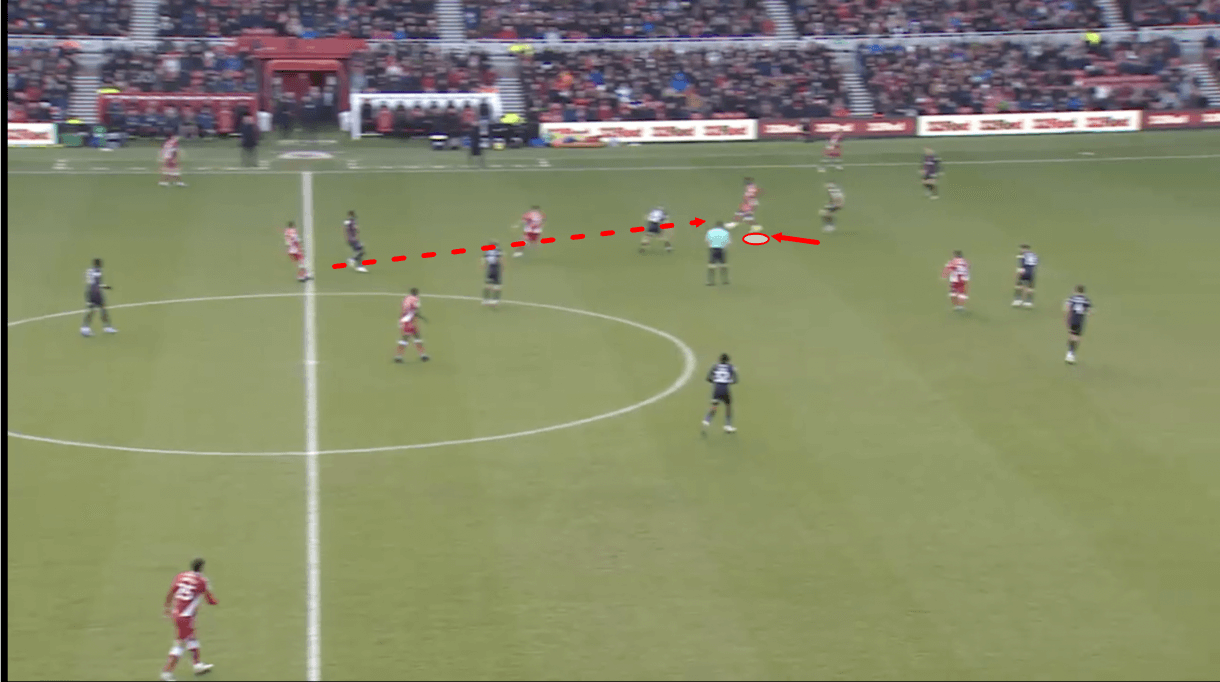
We see a similar situation in figures 8-9, as Balogun receives in the inside left channel with his back to goal while dropping off from the opposition’s backline. Again, his eyes were on the opportunity to link up with a teammate and provide them with a good passing option to progress upfield.
As the attacker received in figure 8, we see a runner moving forward just in front of him, a teammate offering himself for a pass to feet on the left wing and a teammate to link up with centrally.
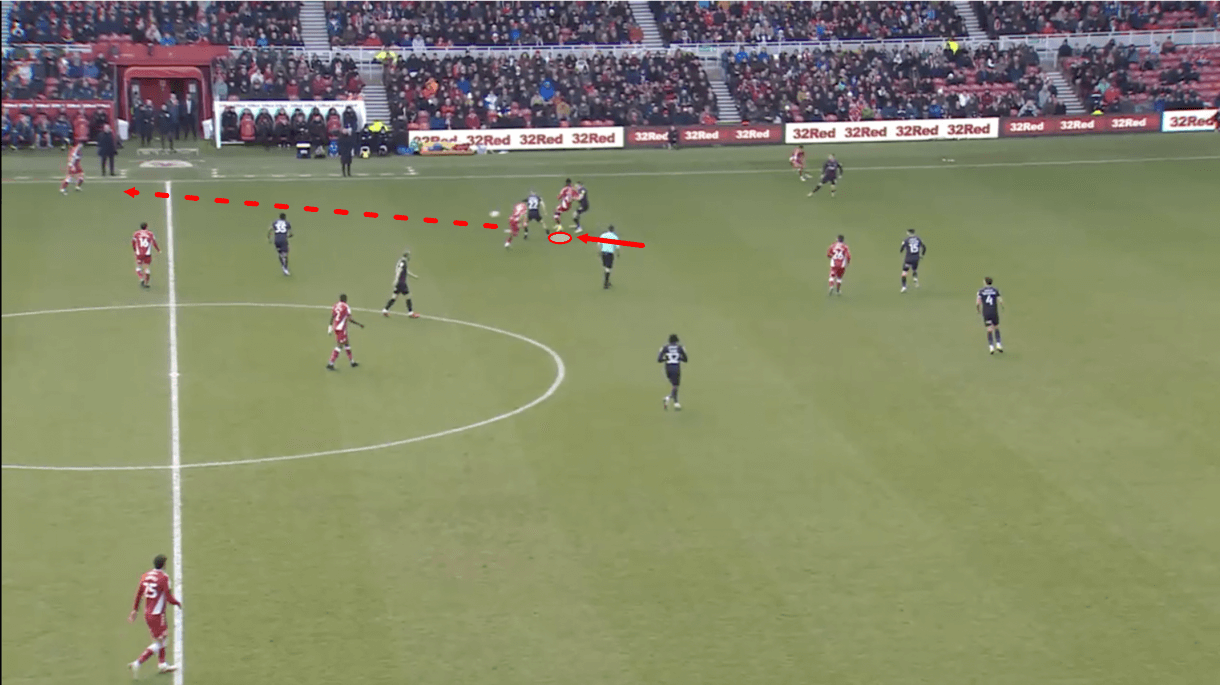
Again, though, Balogun’s scanning and composure let him down, leading to a heavy backwards touch immediately on receiving the ball, leading to it moving back to the left-back. Had Balogun been more aware of his surroundings and/or calmer here, perhaps he’d have taken the option of knocking the ball inside and looking to play a one-two with the centre-forward over his left shoulder — for example.
But the common weakness in his game of poor performance under pressure came to the fore again, leading to the ball moving all the way to the full-back.
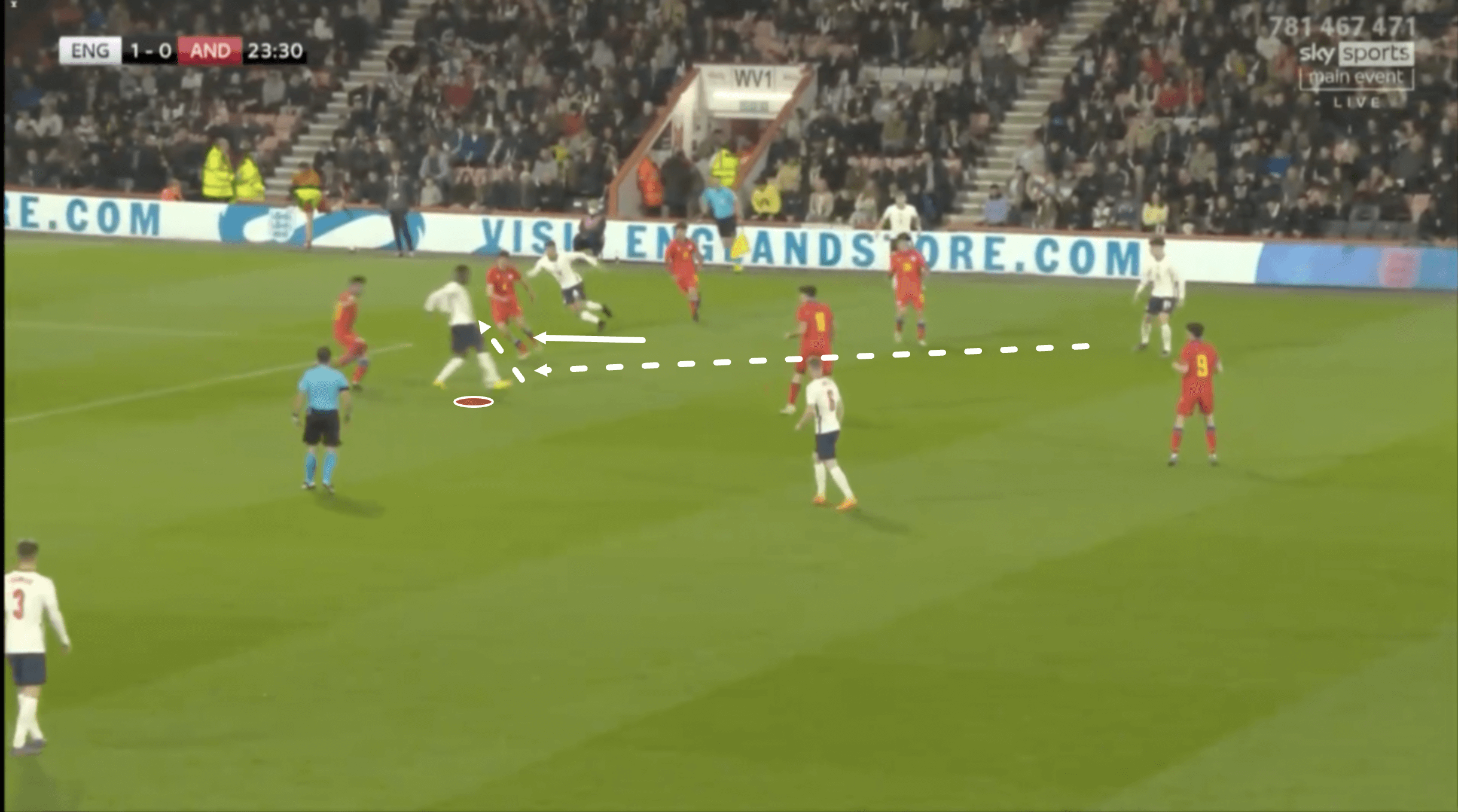
Balogun’s not incapable of splitting the opposition backline when receiving with his back to goal, as figure 10 provides an example of. Here — with his first touch — he takes the opportunity to set the teammate over his left shoulder off in behind the opposition’s backline.
However, the scenario is very different. The teammate is within the limits of his peripheral vision, lessening the dependency on scanning to catch the teammate’s movement. Additionally, he was able to play the ball in behind with his first touch here, again due to the angle he approaches the ball in relation to the angle of his teammate’s run in behind. In the previous examples, he had to take a first touch which allowed pressure from the opposition to build.
In quick exchanges, Balogun typically performs well, barring the poor one-touch pass he has in his locker at times. When given more time to think and, simultaneously, when under increased pressure, Balogun’s scanning and composure have let him down and represent significant areas of improvement for him to focus on at Reims.
Running at defenders
For us, Balogun is very exciting to watch when he receives out wide, turns, and gets his head up and drives at the opposition defender(s). Thanks to his pace, power and decent dribbling ability, he’s capable of making the crowd rise to their feet any time he decides to drive at defenders and engage them head-on. This can increase pressure on the opponents and generate life in his teammates to help the attack.
However, we’d like to see these instances happen more frequently. Most of Balogun’s duels come in the form of receptions with his back to goal and then having a defender approach him from behind. But he possesses enough quality to really hurt the opponent when running at them head-on, as well as create some excitement on the pitch.
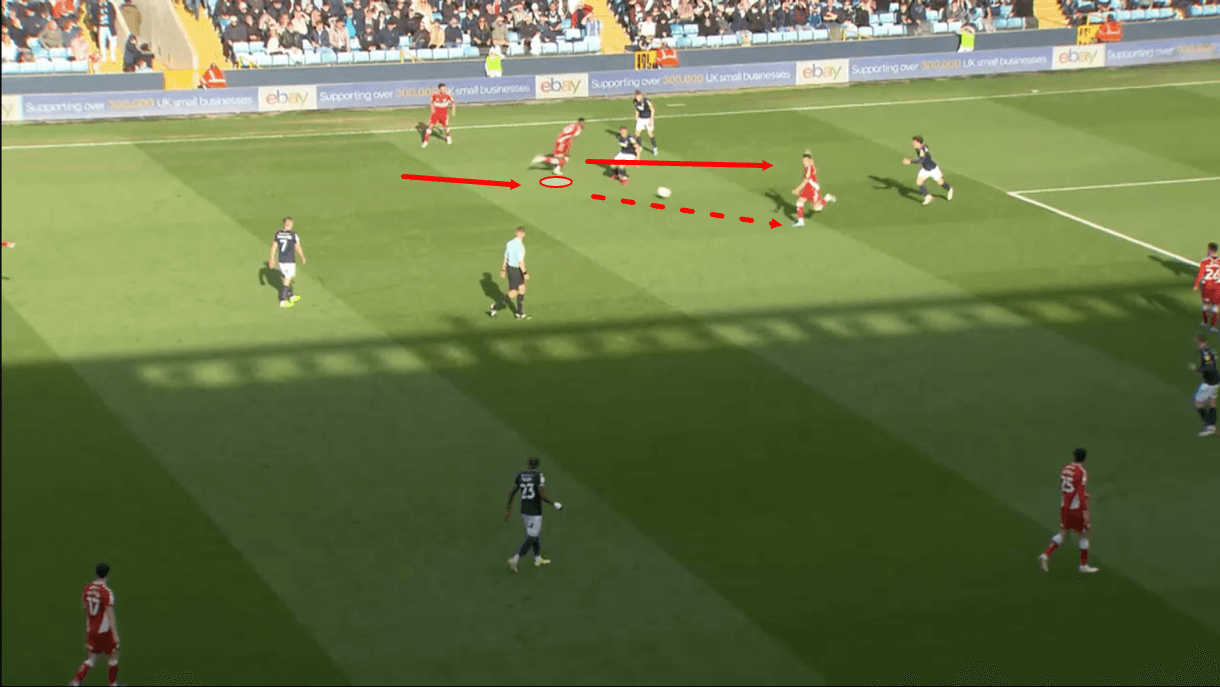
Figure 11 shows an example of Balogun after just dropping deep on the left wing, finding some space, receiving, turning and playing the ball into a more central supporting teammate’s feet. From there, we see the Englishman immediately aim to sprint past the nearest defender he and the central teammate have doubled up on, exploiting the space opening up behind the central defender being attracted to the receiver in figure 11.
This is another example of Balogun’s intelligent movement — something that’s definitely not an area of concern within his game. When he gets his head up off the ball, he’s great at quickly processing the situation and making a good educated decision about how to proceed. This is in contrast to what we discussed about his on-the-ball game in the previous section.
For us, Balogun should allow this area of his game to shine more often, as it’s a major tool he could use to hurt the opponent and help his team. This is something he’s good at and perhaps aiming to exploit this area of his game more often would go some way to accentuating his strengths more, while at the same time hiding his weaknesses more as he would, of course, then be spending less time doing things he’s not amazing at, like what we discussed in the previous section.
This is one reason we feel Balogun would likely be better suited to a wide forward role at present as opposed to a centre-forward, as even though he is capable of picking up good positions centrally and has good movement to link up with teammates, there are also plenty of weaknesses in his game as a central attacker, while that area also provides him fewer opportunities to take defenders head on as we see in figure 11.
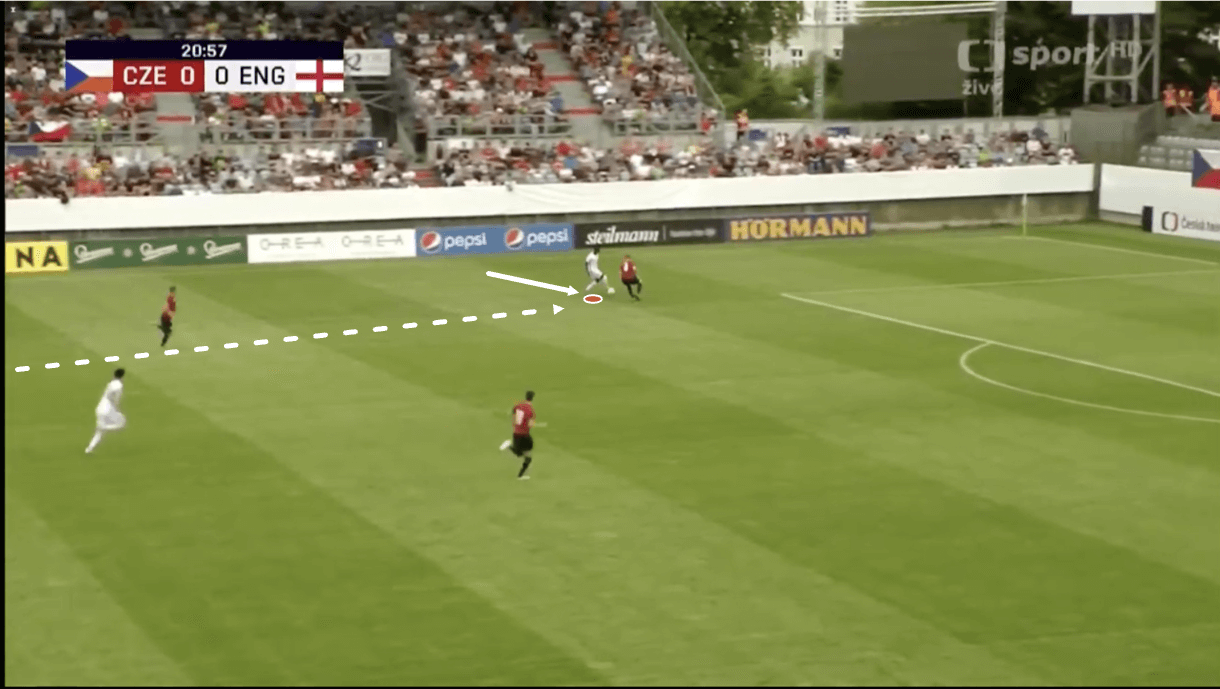
This major strength of Balogun’s game is really useful during transitions — one reason we believe he could suit a transition-based team quite well. He is effective at drifting away from the centre to the left wing, occupying space out there and becoming an option for the team on the counter. On receiving, again as we saw in the previous example and again in figure 12, he is great at taking the defender head-on and threatening to go past them with his pace, power and technical dribbling ability.
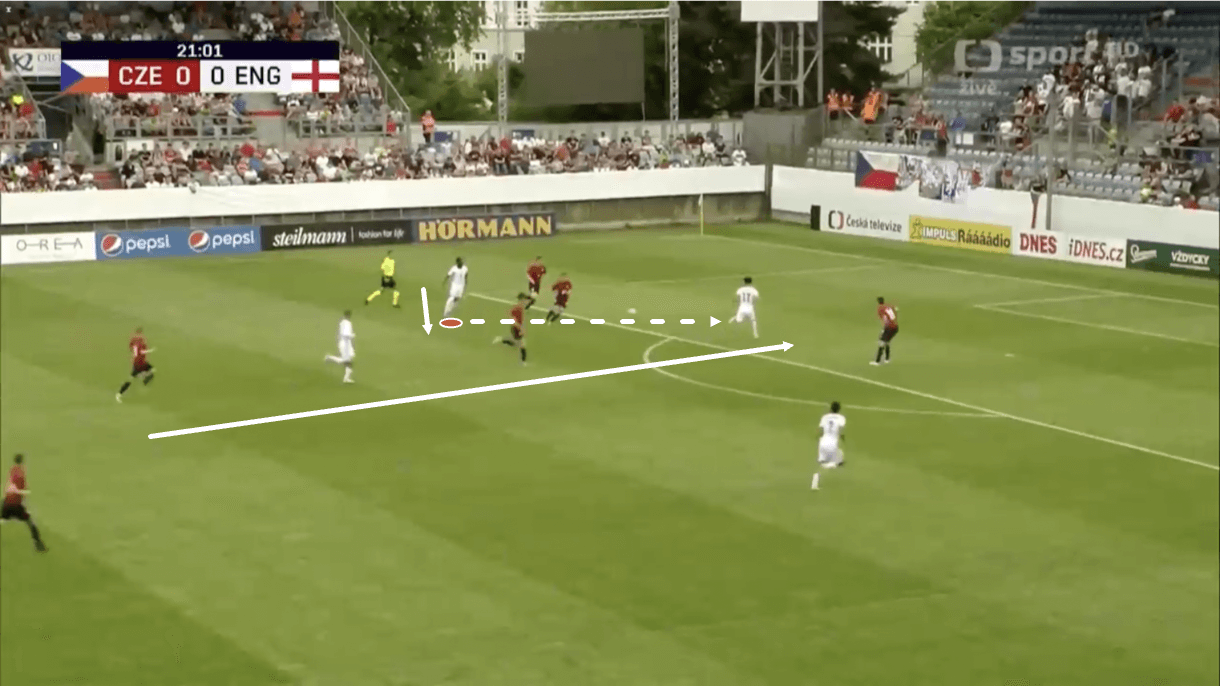
In this case, Balogun did a great job of holding up the play while running at the defender, keeping them guessing and unable to perform a tackle, thus allowing a teammate to arrive in the box from deep to provide Balogun with a creative passing option.
The attacker can split the defence with his through pass and play the teammate through on goal as he arrives in the box, demonstrating good vision and technical ability.
Again, we see an example of Balogun operating very effectively from a wide position here when taking a defender on head-on. Of course, not every instance of Balogun taking on players with dribbles out wide is going to end successfully but it is an area he’s demonstrated good ability in and something we believe he should lean into more often and hone as a key part of his game.
Conclusion
If Balogun replaces Ekitike within Reims’ lineup, he may find himself in wide positions as we mentioned in the final section of this analysis often — assuming manager Óscar García wants to hand him a similar role to the one that the new PSG attacker played at Reims.
This may be a very good fit for Balogun — and vice versa —stylistically. However, in terms of quality, he will be a drop-off for the time being. Should the attacker put in the necessary work to improve in the aforementioned areas, though, he could end up becoming a decent option as a wide attacker on the left in a front three or left-forward in a front two for Ligue 1 level.
At the moment, however, he and his team need to focus on developing in key areas for whatever role he is to play to reach the required standard that Arsenal will also want him to achieve via this loan spell.





Comments